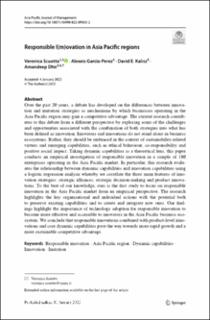| dc.contributor.author | Scuotto, Veronica | |
| dc.contributor.author | Garcia-Perez, Alexeis | |
| dc.contributor.author | Kalisz, David E. | |
| dc.contributor.author | Dhir, Amandeep | |
| dc.date.accessioned | 2023-04-25T11:14:37Z | |
| dc.date.available | 2023-04-25T11:14:37Z | |
| dc.date.created | 2022-05-10T11:13:00Z | |
| dc.date.issued | 2022 | |
| dc.identifier.citation | Scuotto, V., Garcia-Perez, A., Kalisz, D. E. & Dhir, A. (2022). Responsible I(m)ovation in Asia Pacific regions. Asia Pacific Journal of Management, 1-25. doi: | en_US |
| dc.identifier.issn | 0217-4561 | |
| dc.identifier.uri | https://hdl.handle.net/11250/3064902 | |
| dc.description.abstract | Over the past 20 years, a debate has developed on the differences between innovation and imitation strategies as mechanisms by which businesses operating in the Asia Pacific region may gain a competitive advantage. The current research contributes to this debate from a different perspective by exploring some of the challenges and opportunities associated with the combination of both strategies into what has been defined as imovation. Imovators and imovations do not stand alone in business ecosystems. Rather, they should be embraced in the context of sustainability-related virtues and emerging capabilities, such as ethical behaviour, co-responsibility and positive social impact. Taking dynamic capabilities as a theoretical lens, this paper conducts an empirical investigation of responsible imovation in a sample of 180 enterprises operating in the Asia Pacific market. In particular, this research evaluates the relationship between dynamic capabilities and imovation capabilities using a logistic regression analysis whereby we correlate the three main features of imovation strategies: strategic alliances, strategic decision-making and product innovations. To the best of our knowledge, ours is the first study to focus on responsible imovation in the Asia Pacific market from an empirical perspective. The research highlights the key organisational and individual actions with the potential both to preserve existing capabilities and to create and integrate new ones. Our findings highlight the importance of technology adoption for responsible imovation to become more effective and accessible to imovators in the Asia Pacific business ecosystem. We conclude that responsible imovations combined with product-level innovations and core dynamic capabilities pave the way towards more rapid growth and a more sustainable competitive advantage. | en_US |
| dc.language.iso | eng | en_US |
| dc.publisher | Springer | en_US |
| dc.rights | Navngivelse 4.0 Internasjonal | * |
| dc.rights.uri | http://creativecommons.org/licenses/by/4.0/deed.no | * |
| dc.title | Responsible I(m)ovation in Asia Pacific regions | en_US |
| dc.type | Peer reviewed | en_US |
| dc.type | Journal article | en_US |
| dc.description.version | publishedVersion | en_US |
| dc.rights.holder | © 2022 The Author(s) | en_US |
| dc.subject.nsi | VDP::Samfunnsvitenskap: 200::Økonomi: 210 | en_US |
| dc.source.pagenumber | 25 | en_US |
| dc.source.journal | Asia Pacific Journal of Management | en_US |
| dc.identifier.doi | 10.1007/s10490-022-09803-2 | |
| dc.identifier.cristin | 2023000 | |
| cristin.qualitycode | 1 | |

